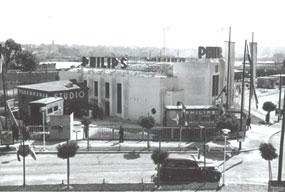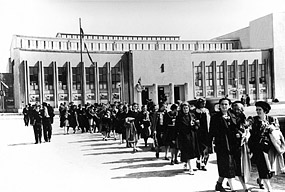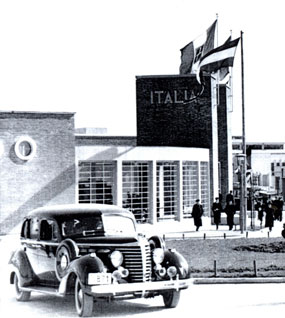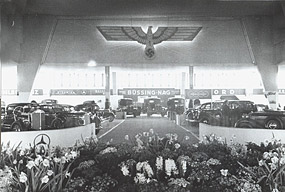English | Srpski
Before 1941: The Belgrade Exhibition Grounds
In 1936, the Belgrade City Council donated 363,000 m2 of land on the previously uninhabited left bank of the River Sava to a group of businessmen, entrepreneurs and investors affiliated to the Association for Organising Trade Fairs and Exhibitions. The Association, established in the 1920s, undertook to transform the marshy site next to the newly built King Alexander Bridge into Belgrade's first exhibition grounds (Beogradsko sajmište). This was the first construction project on the left bank of the Sava, heralding the westward expansion of the capital of the Kingdom of Yugoslavia.
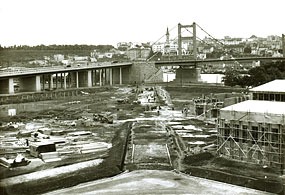

Before and After: Belgrade Exhibition Grounds 1937 (King Alexander Bridge and the panorama of Belgrade are visible in the background)
In the spring of 1937, after draining the first 126,000m2 of marshlands, developers began the first phase of construction, comprising five large pavilions (the so called 'Yugoslav pavilions' 1-5), the central tower, and four 'foreign pavilions': Italian, Hungarian, Rumanian and Czechoslovakian. Also constructed as part of the first phase was the Spasić pavilion (funded by a foundation established by the wealthy Serbian entrepreneur Nikola Spasić, 1838-1916) as well as a number of smaller structures sponsored by private companies, including the Dutch electronics manufacturer Philips. Most of the building work was completed in time for the first Belgrade Fair which opened on 11 September 1937. The second phase of development, which was completed in 1938, involved the construction of the Turkish pavilion and a large German pavilion. In 1940, work began on a new, 6th Yugoslav pavilion, but construction was interrupted by the outbreak of the Second World War.
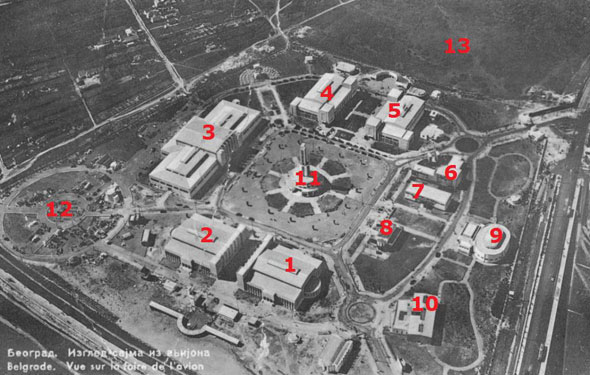
| 1-5 6 7 8 |
Yugoslav Pavilions 1-5 Italian Pavilion Czechoslovakian Pavilion Rumanian Pavilion |
9 10 11 12 13 |
Spasić Pavilion Hungarian Pavilion Central Tower Site of the Skoda tower Site of the German Pavilion (phase 2) |
Sajmište, which was located only a short walk away from the centre of Belgrade, quickly became a popular destination for the city's residents. As well as bringing foreign investors and manufacturers to Yugoslavia, fairs and exhibitions organised there provided ample amusement for the general public. On offer was everything from restaurants, market stalls and street entertainment to the more highbrow cultural events such as classical music concerts and art exhibitions. In September 1938, Philips staged the first television broadcast in the Balkans from its pavilion at the Belgrade Exhibition Grounds. In the same year, as part of an aeronautical show the Czechoslovakian car manufacturer Skoda constructed a 74m tall steel parachute tower, the tallest in Europe at the time, which was used to train parachutists from all parts of the former Yugoslavia. Twenty-five-year-old Katarina Matanović from Zagreb practiced on the Skoda tower before becoming Yugoslavia's first female parachutist.
Importantly however, the Belgrade Exhibition Grounds was not just about entertainment, technological innovation and industrial enterprise. It was also about politics. German and Italian governments used their national pavilions to promote the values of the Nazi and Fascist regimes, respectively. Nazi flags flew prominently in front of the German pavilion, whose interior was similarly adorned with swastikas and other National Socialist insignia. What's more, Germany's expansion in Europe directly affected the look of the Belgrade Exhibition Grounds: in 1939, after the Nazi attack on Czechoslovakia, the name of the Czech pavilion was officially changed into Pavilion of the Protectorate of Bohemia and Moravia. Similarly, in the same year Italy acquired permission to build another, larger pavilion, whose size would reflect its growing military and political influence in the region, including on the Yugoslav government.
Nevertheless, few could anticipate at that time that within five years of the opening of the first Belgrade Autumn Fair in 1942, its pavilions would become a place of The Holocaust, and the site of the largest German-run concentration camp in South Eastern Europe.
Film footage of the Belgrade Exhibition Grounds
Video 1: Summer 1937 - Spring 1938
The first ninety seconds of this video show the construction of the Belgrade Exhibition Grounds in 1937. This is followed by footage from the day of the opening ceremony in September that year. Visible in the video is the Czechoslovakian pavilion - which during the days of the Semlin Anhaltelager (1942-1944) was used to house larger groups of female interns - and the Romanian pavilion which in the spring of 1942 was converted into storage space for the belongings of the Jewish interns executed in the gas van.
The second part of the video shows the opening of the 1938 Spring Fair. The ceremony took place in the entrance hall of the Spasić pavilion, which in December 1941 was converted into the camp infirmary. One of the dignitaries present at the ceremony was Anton Korošec, Yugoslav Minister of the Interior, who in 1940 introduced the so called 'Korošec laws', a series of antisemitic measures which prohibited Jews from trading in food produce and imposed a numerus clausus on Jewish enrolment in schools and universities.
Video 2: Belgrade Exhibition Grounds 1938
The second video contains footage taken after 1938, when the second phase of construction had already been completed. Alongside the Italian and Czechoslovakian pavilions and the Central Tower, the video shows the newly constructed German pavilion with Nazi flags in front of it. During the war, the German pavilion (along with the central tower) housed the camp's Nazi command.
(film footage courtesy of the Yugoslav Film Archive)

